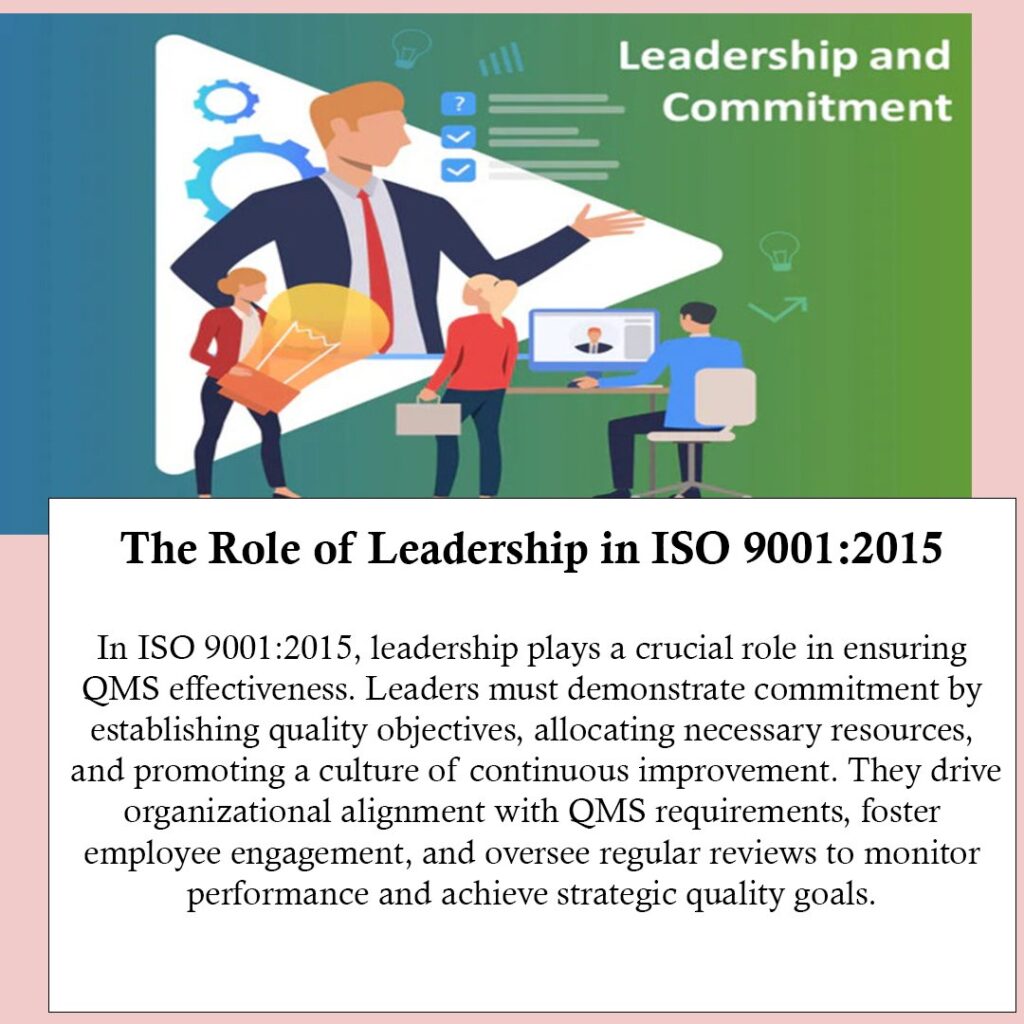Subtotal $0.00

Leadership plays a pivotal role in the successful implementation of ISO 9001:2015, the international standard for Quality Management Systems (QMS). Effective leadership commitment and involvement are essential to establishing a culture of quality, ensuring organizational alignment with ISO 9001:2015 requirements, and driving continuous improvement. This guide explores the critical role of leadership and how top management can effectively lead the implementation of ISO 9001:2015.
1. Setting the Vision and Objectives
Leadership Commitment: Leadership sets the tone for ISO 9001:2015 implementation by articulating a clear vision and objectives aligned with the organization’s strategic goals. This involves:
Communicating Vision: Clearly communicate why ISO 9001:2015 certification is important to the organization, emphasizing benefits such as enhanced customer satisfaction, operational efficiency, and market competitiveness.
Defining Objectives: Establish measurable objectives that align with ISO 9001:2015 requirements, such as improving process efficiency, reducing non-conformities, and achieving certification within a specified timeframe.
2. Providing Resources and Support
Resource Allocation: Leadership ensures adequate resources, including financial, human, and technological resources, are allocated to support ISO 9001:2015 implementation efforts. This includes:
Budgetary Support: Allocate sufficient budget to cover costs associated with training, consultancy, documentation, and certification audits.
Personnel Commitment: Assign qualified personnel to lead QMS implementation teams and provide necessary training and support.
Technological Infrastructure: Invest in technology and tools that facilitate QMS implementation, monitoring, and performance evaluation.
3. Establishing a Quality Policy and Objectives
Quality Policy: Top management plays a crucial role in developing and endorsing a quality policy that reflects the organization’s commitment to meeting customer requirements and achieving excellence through ISO 9001:2015. This involves:
Policy Definition: Define a concise quality policy statement that outlines the organization’s commitment to quality, compliance with ISO 9001:2015 requirements, and continual improvement.
Alignment with Strategy: Ensure the quality policy aligns with the organization’s strategic objectives and values, providing a framework for setting QMS objectives and targets.
4. Leading by Example
Behavioral Leadership: Effective leadership involves leading by example and demonstrating commitment to ISO 9001:2015 principles and practices. This includes:
Active Participation: Engage actively in QMS implementation activities, such as attending training sessions, reviewing QMS documentation, and participating in management reviews.
Adherence to Standards: Demonstrate adherence to ISO 9001:2015 requirements and promote a culture of compliance and continuous improvement throughout the organization.
5. Fostering a Culture of Quality and Continuous Improvement
Cultural Transformation: Leadership fosters a culture of quality and continuous improvement by promoting shared values, behaviors, and practices that support ISO 9001:2015 implementation. This involves:
Communication and Engagement: Encourage open communication and employee engagement in QMS activities, seeking feedback and ideas for improvement.
Recognition and Rewards: Recognize and reward individuals and teams for their contributions to QMS effectiveness and achievement of quality objectives.
Training and Development: Invest in training and development programs that enhance employees’ understanding of ISO 9001:2015 principles, roles, and responsibilities.
6. Ensuring Compliance and Risk Management
Risk-Based Approach: Leadership drives the adoption of a risk-based approach to quality management, ensuring effective identification, assessment, and mitigation of risks that could affect QMS performance. This involves:
Risk Assessment: Establish processes for identifying and assessing risks related to quality, operational, and strategic objectives.
Decision-Making: Incorporate risk considerations into decision-making processes, ensuring informed decisions that prioritize risk mitigation and opportunity realization.
7. Monitoring and Reviewing QMS Performance
Performance Evaluation: Leadership oversees the regular monitoring and review of QMS performance to assess effectiveness, identify areas for improvement, and ensure alignment with ISO 9001:2015 requirements. This includes:
Management Reviews: Conduct periodic management reviews to evaluate QMS performance against objectives, targets, and the effectiveness of implemented processes.
Data-Driven Decisions: Use performance data, metrics, and key performance indicators (KPIs) to measure progress, identify trends, and make data-driven decisions for improvement.
8. External Communication and Stakeholder Engagement
Stakeholder Relations: Leadership manages external communication and engages stakeholders, including customers, suppliers, regulatory bodies, and certification agencies, to demonstrate commitment to ISO 9001:2015 and QMS effectiveness. This involves:
Customer Focus: Foster relationships with customers based on trust, transparency, and a commitment to meeting their expectations for product and service quality.
Regulatory Compliance: Ensure compliance with applicable legal and regulatory requirements, maintaining certifications and licenses essential to business operations.
9. Supporting QMS Audits and Certification
Certification Readiness: Leadership prepares the organization for ISO 9001:2015 certification audits by ensuring readiness, cooperation with certification bodies, and commitment to achieving certification. This includes:
Audit Preparation: Provide necessary documentation, resources, and support for certification audits, including conducting internal audits and addressing non-conformities.
Continuous Improvement: Use audit findings and feedback to drive continuous improvement initiatives, enhancing QMS effectiveness and readiness for future audits.
10. Driving Continuous Improvement
Continuous Improvement Cycle: Leadership promotes a culture of continual improvement by encouraging innovation, learning from experiences, and implementing corrective and preventive actions to enhance QMS performance. This involves:
Feedback Mechanisms: Establish mechanisms for collecting and analyzing feedback from stakeholders, including customers, employees, and suppliers.
Benchmarking: Benchmark QMS performance against industry standards and best practices, identifying opportunities for improvement and innovation.
Conclusion
Leadership plays a crucial role in driving successful implementation of ISO 9001:2015 by providing vision, resources, and commitment to quality and continuous improvement. By actively supporting QMS implementation, fostering a culture of quality, and ensuring compliance with ISO 9001:2015 requirements, top management sets the foundation for organizational excellence, customer satisfaction, and sustainable business success. Effective leadership involvement ensures that ISO 9001:2015 becomes ingrained in the organization’s operations and culture, leading to enhanced competitiveness and stakeholder confidence in the organization’s ability to consistently deliver high-quality products and services